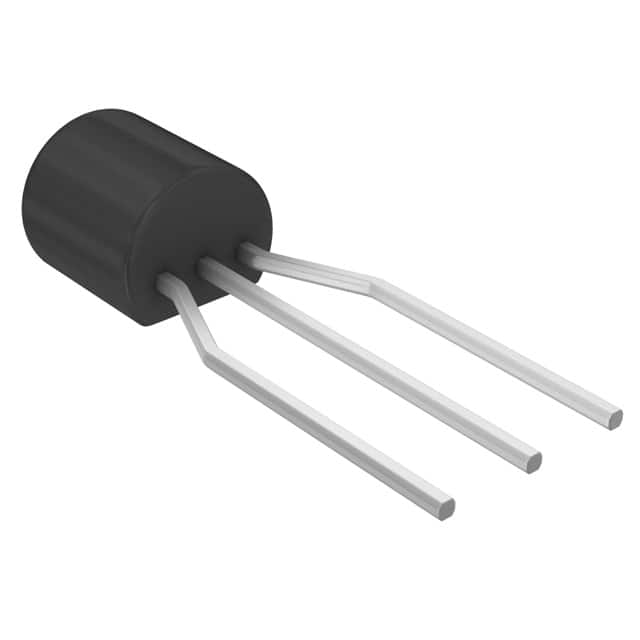TL431CLPRAG
Product Overview
Category: Integrated Circuit (IC)
Use: Voltage reference and shunt regulator
Characteristics: - Adjustable precision voltage reference - Low dynamic output impedance - Wide operating current range - High accuracy and stability - Fast response time
Package: SOP-8 (Small Outline Package)
Essence: The TL431CLPRAG is a three-terminal adjustable precision shunt regulator. It provides a highly accurate reference voltage that can be adjusted to the desired level using external resistors.
Packaging/Quantity: The TL431CLPRAG is available in tape and reel packaging, with 2500 units per reel.
Specifications
- Reference Voltage Range: 2.495V to 36V
- Operating Current Range: 1mA to 100mA
- Temperature Range: -40°C to +85°C
- Output Voltage Tolerance: ±1%
- Dynamic Output Impedance: 0.22Ω
- Cathode Current: 1mA to 100mA
- Anode Current: 1mA to 150mA
Pin Configuration
The TL431CLPRAG has eight pins arranged as follows:
```
| | --|____|-- Vref --|____|-- Anode --|____|-- Cathode --|____|-- NC --|____|-- NC --|____|-- NC --|____|-- NC ```
Functional Features
- Voltage Reference: The TL431CLPRAG provides a stable and precise reference voltage that can be adjusted according to the application requirements.
- Shunt Regulation: It acts as a shunt regulator by maintaining a constant voltage drop across the load, ensuring a stable output voltage.
- Adjustable Output: The output voltage can be easily adjusted by connecting external resistors to the reference and cathode pins.
- Low Dynamic Output Impedance: The TL431CLPRAG exhibits a low dynamic output impedance, allowing it to provide a stable voltage even with varying load conditions.
- Wide Operating Current Range: It can operate within a wide range of current levels, making it suitable for various applications.
Advantages and Disadvantages
Advantages: - High accuracy and stability - Adjustable output voltage - Fast response time - Wide operating current range
Disadvantages: - Requires external resistors for voltage adjustment - Limited maximum output current capability
Working Principles
The TL431CLPRAG works based on the principle of feedback control. It compares the reference voltage at the Vref pin with the voltage across the external resistor network connected to the cathode pin. By adjusting the current flowing through the internal transistor, it maintains a constant voltage drop across the load, ensuring a stable output voltage.
Detailed Application Field Plans
The TL431CLPRAG is widely used in various applications, including:
- Voltage Regulation: It is commonly used as a voltage reference and shunt regulator in power supplies, battery chargers, and voltage regulators.
- Precision Instrumentation: It finds application in precision measurement instruments, where accurate and stable voltage references are required.
- Audio Amplifiers: The TL431CLPRAG can be used in audio amplifiers to provide a stable bias voltage for improved performance.
- LED Drivers: It is utilized in LED drivers to maintain a constant voltage across the LEDs, ensuring consistent brightness.
Detailed and Complete Alternative Models
Some alternative models that offer similar functionality to the TL431CLPRAG include:
- LM431: Manufactured by Texas Instruments, it is a direct replacement for the TL431CLPRAG with similar specifications.
- KA431: Produced by Fairchild Semiconductor, it is another alternative with comparable features and performance.
- TLVH431: Manufactured by STMicroelectronics, it offers similar voltage reference capabilities as the TL431CLPRAG.
These alternative models can be considered based on specific application requirements and availability.
Word count: 511 words
قم بإدراج 10 أسئلة وإجابات شائعة تتعلق بتطبيق TL431CLPRAG في الحلول التقنية
Sure! Here are 10 common questions and answers related to the application of TL431CLPRAG in technical solutions:
Q: What is TL431CLPRAG? A: TL431CLPRAG is a programmable precision voltage reference integrated circuit (IC) commonly used in various technical applications.
Q: What is the purpose of TL431CLPRAG? A: TL431CLPRAG is primarily used as a voltage reference or shunt regulator to provide stable and accurate voltage levels in electronic circuits.
Q: How does TL431CLPRAG work? A: TL431CLPRAG compares the input voltage with an internal reference voltage and adjusts its output accordingly to maintain a constant voltage level.
Q: What is the voltage range of TL431CLPRAG? A: The voltage range of TL431CLPRAG typically varies from 2.5V to 36V, making it suitable for a wide range of applications.
Q: Can TL431CLPRAG be used as a current regulator? A: Yes, TL431CLPRAG can be used as a current regulator by connecting it in series with a resistor and adjusting the reference voltage accordingly.
Q: Is TL431CLPRAG suitable for high-precision applications? A: Yes, TL431CLPRAG is known for its high precision and low temperature coefficient, making it suitable for demanding applications that require accuracy.
Q: Can TL431CLPRAG handle high currents? A: TL431CLPRAG has a maximum cathode current rating of 100mA, so it is not suitable for high-current applications. External transistors can be used to increase the current handling capability.
Q: What are some typical applications of TL431CLPRAG? A: TL431CLPRAG is commonly used in power supplies, battery chargers, voltage regulators, audio amplifiers, and other electronic circuits that require stable voltage references.
Q: How can I adjust the output voltage of TL431CLPRAG? A: The output voltage of TL431CLPRAG can be adjusted by changing the resistor values connected to its reference pin (R1 and R2) according to the desired voltage level.
Q: Are there any precautions to consider when using TL431CLPRAG? A: Yes, some precautions include ensuring proper decoupling capacitors, avoiding excessive heat dissipation, and following the manufacturer's guidelines for stability and reliability.
Please note that these answers are general and may vary depending on specific circuit designs and applications.


